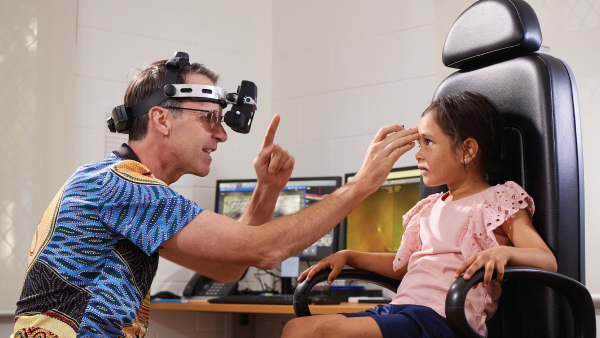Journal of a Rural Australian Eye Doctor
Collaborative care and AI – my experiences working as an ophthalmologist in remote regions of Western Australia
Living and working as an ophthalmologist in Broome, a small town in the Kimberley region of Western Australia (WA), has offered me a unique perspective on the challenges of delivering eye care in remote areas. One of the pressing issues in regional WA is the shortage of ophthalmologists, an issue that’s compounded by the vast distances and the isolation of many communities in the region. However, through collaborative care efforts, as well as the integration of innovative technologies like artificial intelligence (AI), I’ve witnessed significant improvements in our ability to provide essential eye care to these neglected communities.
The reality of working in a remote area
With Broome as my base (1300 miles from the metropolitan city of Perth), I travel the length and breadth of the state regularly for one or two day specialist visits with the support of a dedicated team, including multiple junior residents. The vast distances between communities and the limited number of specialists create unique challenges for our team. Many of my patients would have to travel long distances for care, and where possible we make every effort to reduce the barrier by providing surgery close to home or harnessing telehealth. The situation is even more critical when you consider that First Nation populations in Australia face disproportionately high rates of blindness and vision loss (1).
Embracing collaborative care
Collaborative care has proven to be a transformative approach for our team over the last decade. Partnering with optometrists and ophthalmic nurses has allowed us to optimize our resources. Optometrists handle screenings and manage common ocular conditions, which enables excellent distillation of pathology and allows visiting specialists to focus on surgical care without duplicating our efforts. All pre- and post-operative work for surgery is handled by optometry, including video ophthalmology consent processes. This teamwork means that patients are able to get timely and comprehensive care, even in these remote areas.
A notable addition to this approach is the integration of Aboriginal eye health workers into our network. Their local knowledge and cultural insights are invaluable, particularly when working with Indigenous communities. This collaboration helps to bridge gaps in care and ensures that our services are more accessible and culturally sensitive than they previously were.
The most rewarding aspect of this collaborative approach is to see how it improves patient outcomes. The coordination between different eye care professionals means that patients, no matter where they live, get comprehensive care tailored to their specific needs. It’s a patient-centered model that I’ve seen make a real tangible difference to the lives of my patients.
The impact of AI
The integration of AI into our practice has also been a game-changer. Lions Outback Vision, an ophthalmology service dedicated to improving access to eye care in Western Australia, has introduced the use of AI-powered diagnostic tools in our practice. We have recently been awarded a $5M AUD prize in a global digital health competition called “The Challenge” for a real-world deployment proof of concept. We undertook a road test, comparing cameras and deep learning systems head-to-head for prospective, real-world outcomes. To this end, our collaborations with Google Health, Topcon, Optomed, and University College London (UCL) have brought global expertise to our remote outpost. The real-time diagnoses provided by the AI system enables non-eye trained staff to detect and address issues early, which is crucial for preventing vision loss.
On-demand video telehealth is also now available, which has been shown to increase Aboriginal patient access tenfold (2). The telehealth systems we have installed, including cloud-based access real-time imaging and video call, have led to reduced patient waiting times, received excellent patient feedback, continue to ensure excellent triage for surgical trips, and have been highlighted by the World Health Organization in their Global Vision Report (3).
The Lions Outback Vision team has also deployed treatment closer to home, with intravitreal injections across the regions administered by junior medical staff (4) and a novel lightweight, head-mounted laser (Norlase) for treating diabetic retinopathy now being made available to surgeons in the country.
Cultural sensitivity and education
Understanding the cultural context of our patients is essential. Lions Outback Vision has developed a culturally appropriate education video about diabetic retinopathy, available in both English and Martu Wangka – the most commonly spoken Indigenous language in the Pilbara. This resource improves patient understanding and awareness of diabetic complications, which is vital for effective disease management and prevention.
Looking ahead
I am optimistic about the future of eye care in remote areas like Broome. Collaborative care and AI are not just theoretical solutions; they are practical, effective methods that are making a real difference on the ground. The combination of skilled professionals working together, cultural sensitivity, and innovative technology is transforming how we deliver eye care, especially in underserved communities.
As we continue to embrace these advancements and refine our practices, I am hopeful that we will overcome the challenges of distance and shortage, ensuring that everyone, regardless of their location, has access to the eye care they need. Each day in Broome reaffirms my belief in the power of innovation and teamwork to make a meaningful impact on our patients’ lives.
This article first appeared in The Ophthalmologist.
References:
Australian Institute of Health and Welfare, Indigenous eye health measures 2021. IHW 261. 2021, Australian Institute of Health and Welfare: Canberra.
AA Nguyen et al., “On-call telehealth for visiting optometry in regional Western Australia improves patient access to eye care,” Clin Exp Optom, 103, 393 (2020). PMID: 31646665.
World Health Organization, World report on vision. 2019: Geneva.
JCC Lee et al., “Endophthalmitis following intravitreal injections administered by junior medical officers in rural Western Australia,” Clin Exp Ophthalmol, [Online ahead of print] (2024). PMID: 39053910.
The New Optometrist Newsletter
Permission Statement
By opting-in, you agree to receive email communications from The New Optometrist. You will stay up-to-date with optometry content, news, events and sponsors information.
You can view our privacy policy here
Sign up to The New Optometrist Updates
Permission Statement
By opting-in, you agree to receive email communications from The New Optometrist. You will stay up-to-date with optometry content, news, events and sponsors information.
You can view our privacy policy here
Sign up to The New Optometrist Updates
Permission Statement
By opting-in, you agree to receive email communications from The New Optometrist. You will stay up-to-date with optometry content, news, events and sponsors information.
You can view our privacy policy here









